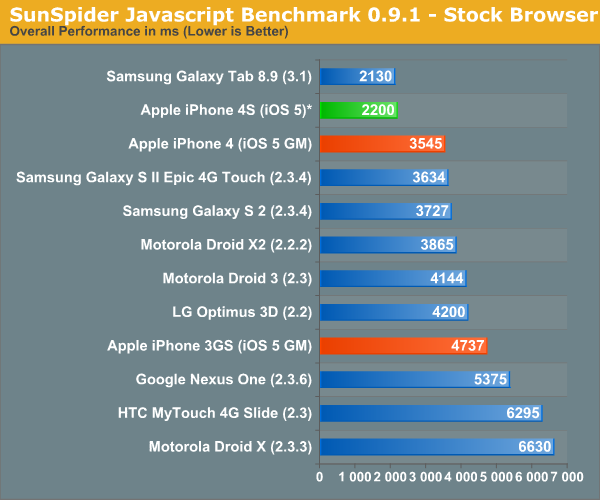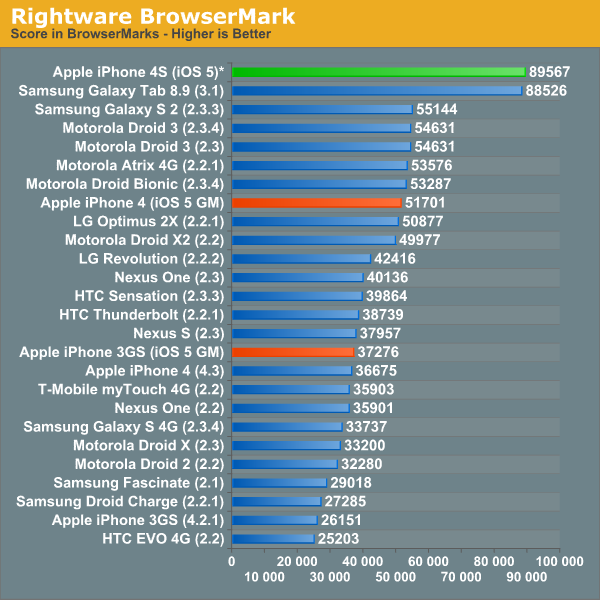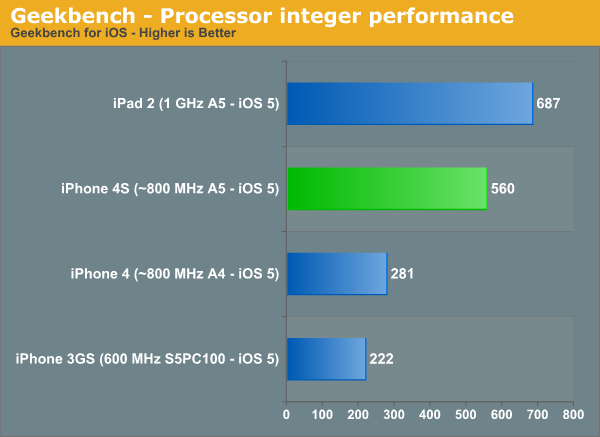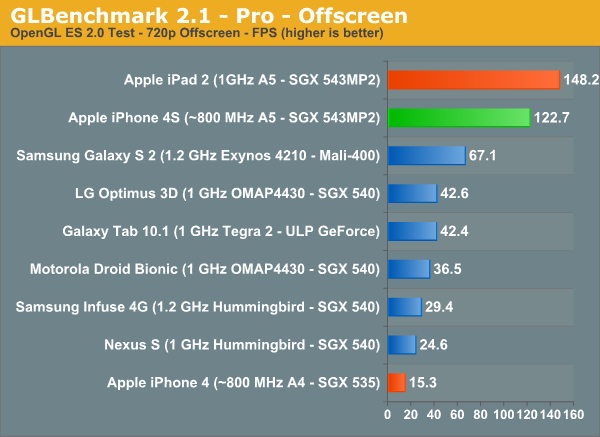iPhone 4S Preliminary Benchmarks: ~800MHz A5, Slightly Slower GPU than iPad 2, Still Very Fast
by Anand Lal Shimpi & Brian Klug on October 11, 2011 3:22 AM EST- Posted in
- Smartphones
- Apple
- Mobile
- iPhone 4S
- SoCs
Apple's ability to control the entire information chain, down to the point of limiting leaks, appears to be gradually slipping as it grows as a company. Case in point are the numerous hardware and performance leaks surrounding the newly launched iPhone 4S. Little did we know that several weeks ago we were staring at photos of the 4S' PCB, and more recently we've seen the first performance results from Apple's first A5 based smartphone thanks to a few eager users around the web. We've compiled these results here from various sources (all linked below) and compared them to our existing database of tests.
The results are pretty much as expected. Javascript performance finally catches up to Tegra 2 based Honeycomb devices, while general CPU performance is significantly higher than the iPhone 4. I suspect Ice Cream Sandwich will bridge the Android smartphone gap (the Honeycomb equipped Gtab 8.9 is here to give you an idea of where a more modern Android browser ends up).
Keep in mind that all of these tests measure performance of the software stack in addition to the hardware. In particular the web browser tests depend largely on browser optimizations, which is why we see differences between similar hardware running different browser versions. Also note that all results were run at stock, with the stock browser. Finally, although these browser tests were captured on video we'll still be running our official tests once our 4Ses arrive and will update accordingly.


Using some of the integer and fp tests of published Geekbench scores we can already conclude that Apple is shipping a lower clocked A5 in the iPhone 4S than it does in the iPad 2. This naturally makes sense as the iPhone 4S has a much smaller 5.25 Whr battery. Based on the Geekbench results it looks like the iPad 2 is clocked around 25% higher than the iPhone 4S, pegging the latter's clock speed at 800MHz.


A lower clock not only means higher yields from the factory, but likely a lower operating voltage as well. Dropping a CPU's core voltage, yields a greater-than-linear decrease in power consumption, making the marginal loss in clock speed a good choice. At a lower operating frequency than its Android competitors, Apple does have to exploit its strengths in software to avoid any tangible performance penalties. Apple has traditionally done this very well in the past, so I don't expect the loss of frequency to be a huge deal to the few who do cross-shop iOS and Android.
Unsurprisingly, memory bandwidth doesn't appear to have gone up either compared to the iPad 2's A5 (taking into account scaling due to CPU clock increases). The Samsung part number on the iPad 2's A5 indicates two LPDDR2-800 die on package, it's safe to assume that whatever Apple clocked the memory interface at in the iPad 2 remains unchanged in the iPhone 4S.
The GPU results tell a similar story courtesy of some early GLBenchmark 2.1 results. The 960 x 640 results are useless as they are bound by vsync at ~60 fps. Luckly GLBenchmark 2.1 added an off-screen render mode at 1280 x 720 where we can really see the differences between the iPad 2 and iPhone 4S A5 implementations:


Here the iPad 2 holds a ~21% performance advantage, which once again I assume to be all related to clock speed. Also note the huge advantage over the existing iPhone 4. The GPU power in the 4S should be more than enough to run any well written, current generation title at well north of 30 fps on its display.
We'll be reviewing the iPhone 4S in the coming weeks, stay tuned!
Source: GLBenchmark Database, Geekbench Database, Macrumors










216 Comments
View All Comments
WaltFrench - Tuesday, October 11, 2011 - link
“Android is built for a wide variety of hardware, so unlike Apple they can't make a full out push for dual core optimization exactly when the hardware is available, so the software lags a bit.”May I fix that for you?
“When you buy a particular Android device, you pretty much know it'll be a cobbled-together combination of some generic OS design, hardware that wasn't known to the OS designer *OR* the app developer, and was then sold thru a carrier that doesn't give a rat about anything other than signing you up for two years' worth of $79/month plus fees.”
Besides seeing whether ICS makes better use of multicore, it'll also be interesting to see whether Google's promised tighter control over the OHA means that upgrades get to users faster than they did in the past.
deV14nt - Wednesday, October 12, 2011 - link
Eh. Just speaking of the flagship Galaxy S II, Samsung does just fine at integration. They also happen to be the world's largest mobile phone manufacturer. Anyway, they use Google's OS and value-added services, their in-house top-notch TouchWiz interface, their in-house top-notch processor, their in-house top-notch screens, their in-house memory.Samsung actually makes more of the phone themselves than Apple does. Actually, as far as manufacturing goes, Samsung may make more of the iPhone than Apple does. Just saying...
doobydoo - Sunday, October 16, 2011 - link
Yet they still can't create a phone as good as the iPhone 4S, without infringing copyrights./Fail
tnrmem - Tuesday, October 11, 2011 - link
Thanks for the reply. Yes, my quoted value of around 1750ms is based on a third-party browser (Dolphin HD) on the latest version of CM7 (currently on Android 2.3.7). I'm also sporting an international SGS2 (i9100) version. Using the stock Android browser to run SunSpider yields a slighter higher time of around 1800ms.But now that you mentioned it, I am getting these values using SunSpider 0.91 instead of your 0.9. I did the tests again and got a higher value of 2466ms, which may explain the rather large disparity of the original results.
I also managed to secure an unmodded SGS2 from a friend to run the same tests. The same i9100 version runs on stock 2.3.4 UHKG7 with all the original bloat and more. Running SunSpider 0.91 on stock browser produces a value of around 3200ms so I guess your 4000ms+ result might be plausible on the previous 0.9 version. I am rather surprised with these values as I didn't notice much difference in browsing performance (and speed in general) between CM7 and stock ROMs. Sadly, I didn't get to test the BrowserMark scores as the website seemed to be overloaded then.
I don't really know what to make of these values or what they are dependent on, but I am curious about the large disparities especially when compared to the new iPhone (given the hardware on both are pretty similar except GPU). I love all your articles by the way. Keep up the good work!
steven75 - Tuesday, October 11, 2011 - link
Why would a review site compare a stock iPhone vs a rooted and rom'ed Android phone?That would make no sense.
Aikouka - Tuesday, October 11, 2011 - link
I think it would be interesting to see stock Android vs. homebrew Android.WaltFrench - Tuesday, October 11, 2011 - link
What do you think it would show? That Samsung is incompetent? That 3rd parties can optimize JavaScript if they don't have to worry about playing nice with RAM or other tradeoffs that the most-frequently-used app has to do?I hear tell of various “security” features built into stock OS distros, but I wouldn't think javascript performance would be the first place you'd expect to see a performance hit.
mongo lloyd - Tuesday, October 11, 2011 - link
Latest stock in Kies for the international version is KI8 (2.3.5) from last week.germz1986 - Tuesday, October 11, 2011 - link
My sensation gets 2500 @ stock clocks and 1915 @ 1.5ghz, which is the stock clocks for the Sensation XE. Lets have a little less apple fanbio'ismSwapzzz - Tuesday, October 11, 2011 - link
totally agree!